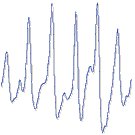
The Huguenard Lab
Some Major Completed Projects
Endocannabinoid signaling in the cerebral cortex
We demonstrated a novel form of endocannabinoid-mediated inhibition, SSI, in the neocortex of rats (Bacci, et al. Nature, 431:312-316, 2004). There has been much interest in recent years regarding retrograde neuronal signaling via these cannabis-related chemicals. Our results show a very different action, not relying on back-propagation of signals from a recipient neuron backwards to the neurons sending the message. Instead SSI may be dependent on actions that occur exclusively within the membranes of inhibitory interneurons. Similar actions may account for some of the cognitive effects of marijuana. Read more about these results.
Knockout of the GABAA Beta3 subunit leads to hypersynchrony in thalamic networks
We have published studies (e.g., Huntsman, et al. Science 283:1999) that examined the possible functions of reciprocal inhibition in the thalamic reticular nucleus. These recurrent connections have been hypothesized to be important in the generation of synchronous discharge during sleep. However our results suggest the opposite. In mice that had an inactivated Beta3 gene (GABRB3), we found that inhibitory synaptic responses within the thalamic reticular nucleus were nearly abolished. Concurrent with this change was a massive increase in thalamic oscillatory synchrony. This suggests that inhibition within the reticular nucleus serves a desynchronizing function.
Other Projects
- The effect of adenosine on thalamic synaptic transmission and oscillations.
- Modeling of thalamic neuronal activity.